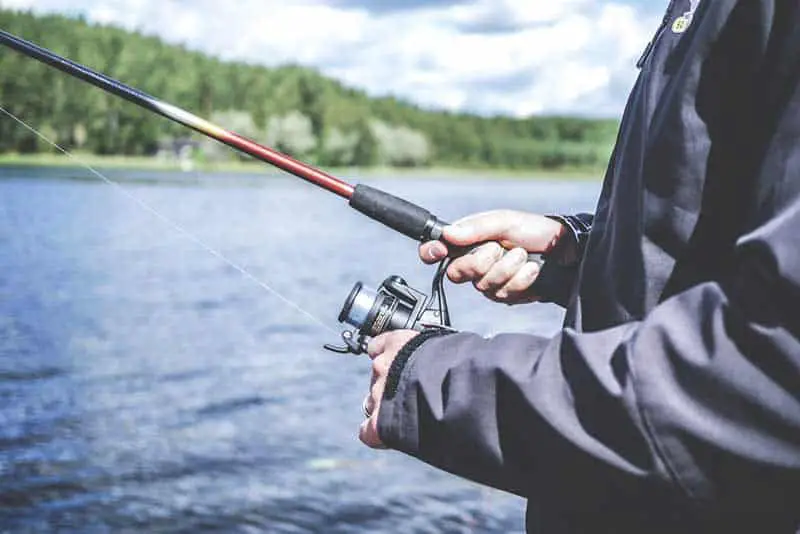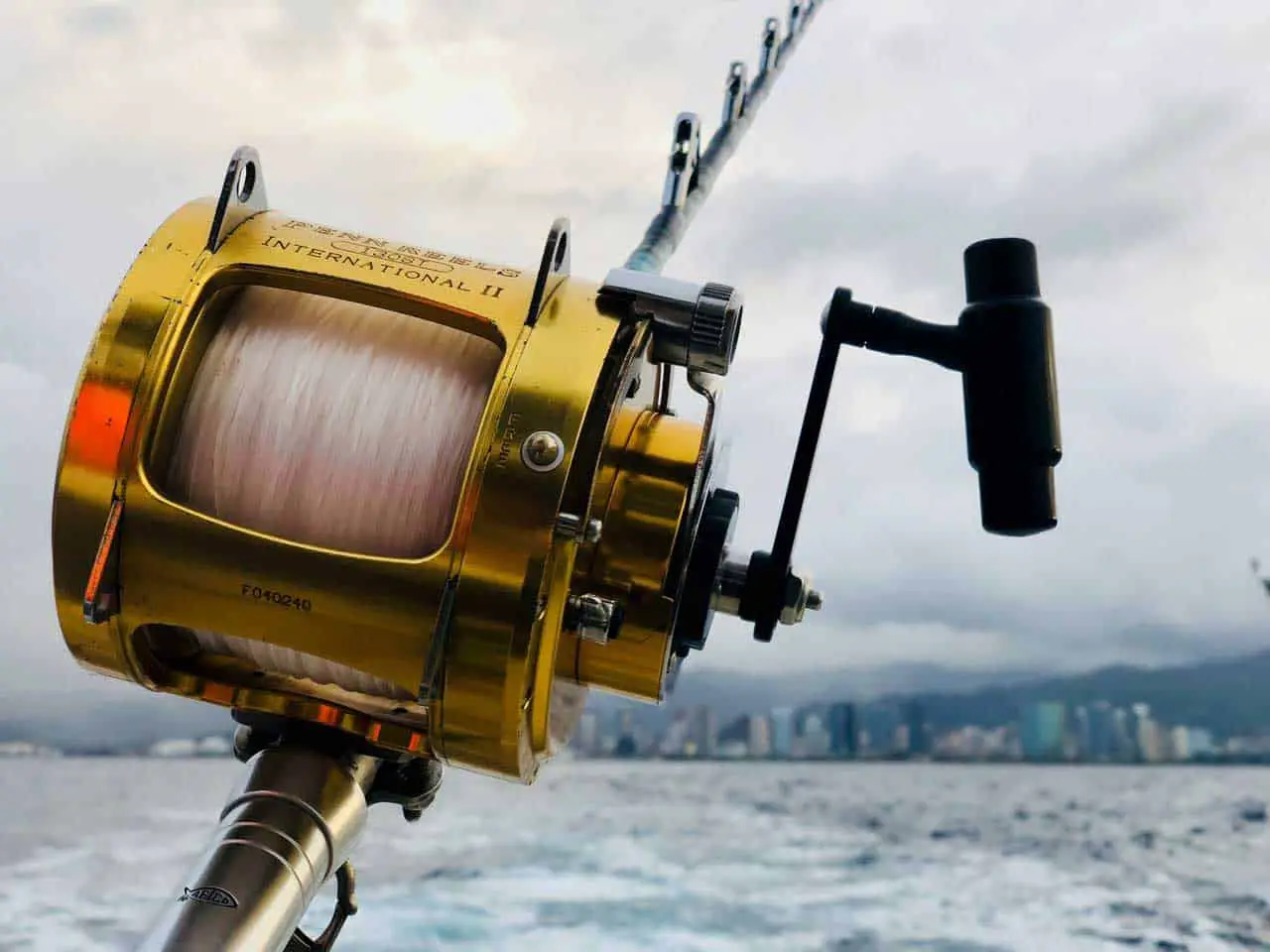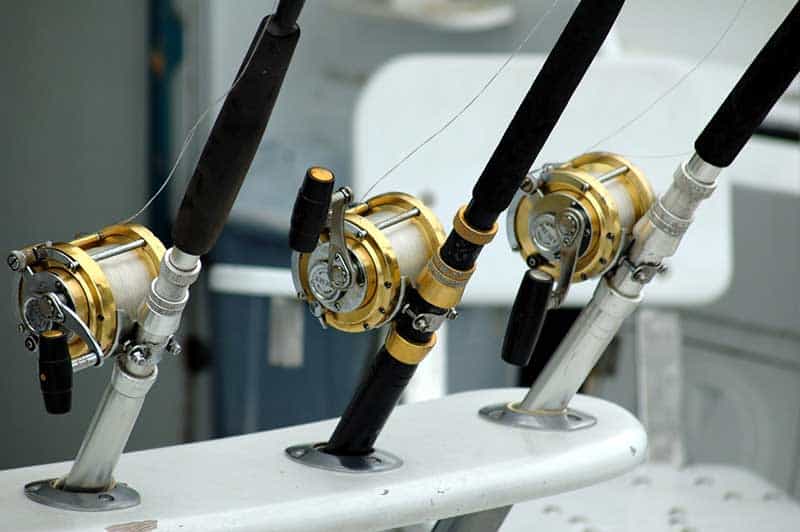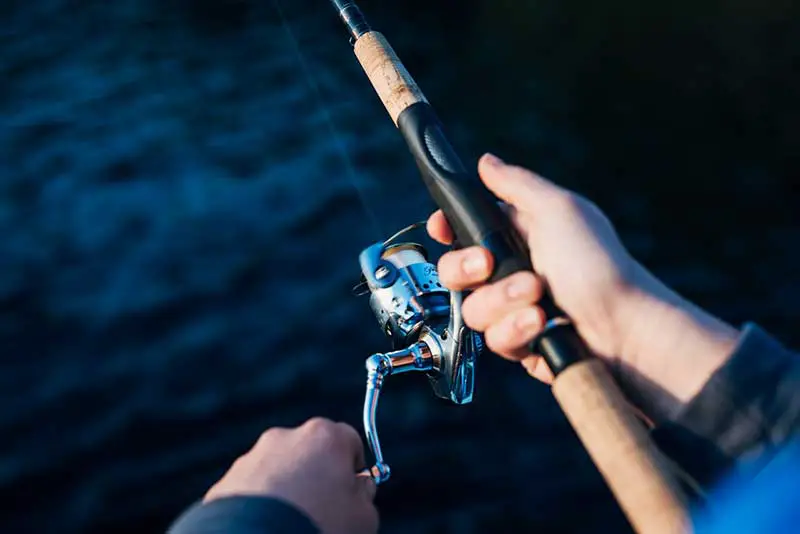Table of Contents
*This post may contain affiliate links. As an Amazon Associate we earn from qualifying purchases.
Whether dipping into the water and coming out with dinner, or catching and releasing that fish, a bit of adventure can be a truly victorious experience. Before you can bring home today’s fresh catch to try your hand at homemade sushi, you must figure out where there might be some fish to be caught, and get your hands on the right kind of fishing gear to get them out of the water and into your cooler.
In this article, we’ll explore the various types of fishing reels and the kinds of fish and situations you in which you would use them. From there, check The Fishing Master for more on lines, rods, hooks, bait and all things fishing.
Fishing 101: What Is a Fishing Reel?
Let’s face it, we don’t all start off with the comprehensive knowledge of everything in a given sport or hobby, and fishing is no different. While we know the verb to reel means to pull in, which is what we hope to do with fish, it is important to clarify that a fishing reel is a device to which your line is attached for there are many types of fishing reels. The fishing reel is a cylindrically shaped device attached to the fishing rod. The reel is used to provide a basic and fundamental task—the winding in and storing of our fishing line.
The Basics of Fishing

Image via Pexels
To fish, we attach the hook to the end of the line with relevant bait on it to attract the fish that might be locally available. We then cast the line into water in order to attract the attention of fish. In both still water and ocean fishing the line with the hook is cast directly into the water and may even have a sinker attached to it to bring line lower into the water or directly to the bottom.
The line can be held taut with the reel and then teased back and forth to move the bait about in the water. Fly-fishing involves touching the bait down atop the water and quickly taking it away to resemble the flies that the fish leap out of the water to snap up, although generally a fishing reel is not used for this type of fishing as there aren’t great demands for a lengthy line.
Fishing Reels from Then to Now

Image via Pexels
Most modern fishing reels have fittings that aid in the line’s casting and improve both accuracy and distance. The ability to retrieve the line is often enhanced in modern fishing reels, especially those designed for sporting and larger fish. Fishing reels are attached to the fishing rod and generally are used in the recreational sport of angling as well as in competitive casting applications.
The history of the fishing reel is quite extensive. The first fishing reels appeared in the Song Dynasty of China. Evidence of this existence was recorded in paintings beginning in 1195 AD although written descriptions of fishing reels in China dating back to the third century AD.
The First Fishing Reels (300-1100AD)
In terms of fishing technology, Chinese fishing reels were used for many centuries, if not for more than a millennium, before the rest of the world followed suit. It would take time for the technology to spread and/or develop elsewhere. Shifting forward to the modern Western world, many types of fishing reels first made their way to England in the mid-17th century. By the mid-18th century, the fishing reel was popular in London with many variations available on the commercial market. The first fishing reel to gain popularity in the United States did not appear until the early 19th century.
English Fishing Reel Development (1800s AD)

Image via Pexels
In England, the earliest types of reels to emerge were the multiplying reels. Earlier versions of this fishing reel were wide with a small diameter and were noted for their brass gears that would wear relatively quickly. The Nottingham reel would then take over as the more popular types of fishing reels, with a wide drum that spooled out freely and allowed the bait to drift along with the water’s current. The regulator was invented to prevent the tangling of increasingly thinner fishing lines. The fixed-spool spinning reel was designed in 1905. It allowed for much lighter lures as the line drew from the leading edge of the spool and was restrained and rewound by a line pickup—a device that rotates around the stationary spool.
American Fishing Reel Development (1800s AD)
While the geared multiplying reels of England initially were adopted in America, George Snyder of Kentucky would take this design and modify it to invent his baitcasting reel in 1810. A reel and fly design by Charles F. Orvis (after whom a common fishing knot is named) would design and distribute a reel and fly design in 1874, which was the first fully modern fly reel.
Having swam through the rich historical waters of fishing reels, now let’s move onto the discussion of the types of fishing reels currently available on the market, and the kind of fish they will help us to reel into our boats.
Types of Fishing Reels and What They Reel In
Now that we’ve covered a basic overview of fishing and the development of reel types, it is now time that we move through the various types of fishing reels that are available to help us bring in those fish. We’re going to explore the most common types of fishing reels by explaining their design, function and, most importantly, the kind of fish they catch for you to reel ashore into your boat, kayak, surfboard, or who knows what. Maybe you have a hovercraft dedicated to lake fishing. Whatever your fishing format, these reels will help you out.
Spincast Reels
The spincast reel is to the modern American the most likely reel they used as a kid. It is used generally in recreational, angler fishing rod packages or for fishing rods geared toward beginners, for this type of fishing reel is quite easy to use. There is a push-button release in the back which allows the line to cast. Simply turn the rod back with the baited up lure behind you with a few feet of extra line until you get more comfortable. Make sure there are no people for the hook to get caught on and arc your fishing rod overhead, making the lure arc up as well. As the rod faces the ocean, press the button to allow the line to release and the momentum and weight of the lure will cast it outward into the water.
The spincast reel generally has lower line capacity than other reel formats. In terms of the type of line that spincast reels can handle, the options also are somewhat limited. Using heavy test line in a spincast reel is generally not advised, and so big game fish are not on the menu if you are using a spincast reel. The spincast reel is designed mainly to draw in smaller fish, and so it is great for some lake fishing, pond fishingand off-shore fishing. But, if you’re going out into the deep blue sea for fishing, it is best to use a rod that could handle a giant tuna—should you be so lucky as to hook one, of course. Hooking one and losing it to an insufficient reel would be a lot worse, so let us move onto a better reel for those bigger and badder fish.
Baitcasting Reels
One of the most common types of fishing reels used by angers are baitcasting reels. The baitcasting reel has a number of advantages, namely it has no line twisting during the release of a cast. That means there are far fewer issues that you will encounter in terms of tangled lines. An additional benefit of the baitcasting reel is that it channels more power, allowing for greater distance casting.
The types of fish that you can reel in with the baitcasting reel varies according to the specific reel design. There are both light and heavy versions of the baitcasting reel, so you can choose which type to go for depending upon the fish you are hoping to catch. The baitcasting reel also provides a much higher level of control and accuracy when casting into the water than other reel designs such as spinners, but they can prove to be a bit difficult to get used to at first. But as with anything, practice makes perfect, and if you keep at with the baitcasting reel, you will find your distance and accuracy to be excellent—once your control has been developed that is.
Baitcasting reels generally are split into two sub-categories: the round baitcasting reel and the low-profile baitcasting reel. The round baitcasting reel has a larger spool allowing for more line to be held. This style is best when you want to cast a line into the sea to test out the limits of your strength—with the long-distance fishing cast being one of the more awesome experiences we get to have when partaking in some fishing. Plus, it can be sad to watch a perfectly outward bound cast cut short when the line runs out of length before your cast runs out of momentum.
The low-profile baitcasting reel is growing in popularity due to how simple it is to use. The low-profile options are lightweight and easy to handle and their design is more ergonomic. While it cannot handle fish quite as large as the round baitcasting reel option, the low-profile can handle big game fish with the right line. An added bonus to this design is that it also significantly reduces twists in your line.
Spinning Reels
One of the most popular types of reels used today is the spinning reel. There is an ongoing debate in the fishing community about the top fishing reel types with popular opinion falling either on the side of the spinning reel or the baitcaster reel. The spinning reel is a highly versatile option that can be used in any body of water. So, whether it be a cast off the dock into a lake or a cast of your line from a kayak paddled off the coastline of the Atlantic Ocean spinning reels are the one to use. To cast a spinning reel, you flip the metal bail wire upwards, releasing the line for the cast. Flipping the metal wire down locks the line into place—quite a simple process.
When casting from a spinning reel, the line soars outwards from the front of the spool. This gives a very cool and dramatic look, especially if you’ve taken the time to stylize your lure for maximum panache. As the line is reeled back in on the spinning reel, the reel literally spins (hence the name.) Apparently the creator was not like Charles F. Orvis and felt the need to name the reel after herself or himself. The setup is obvious and simple, making it a favorite of many a fisherman and fisherwoman. The spinning reel is even easier to use than the spincast reel, given the exposed nature of the line, and is more accessible than the baitcaster format for the beginner fisherman and fisherwoman.
Saltwater Fishing Reels for On-Shore or in the Open Sea

Image via Pexels
Thus far, we have explored three types of fishing reels that are made to be versatile and can be used in a variety of environments—although the spincaster is noted as being limited to smaller fish given the short cast and thinner line capacity. Now we will move onto some more specialized types of fishing reels that are designed for the ocean-going fishermen and fisherwomen who are out for those bigger catches—whether they be fishing off the coastline, wading in water or casting from boats into the deep sea.
Reels designed for fishing in the ocean are called surf fishing reels, and given the stronger waters and bigger fish, the design of such reels must be capable of responding to the greater and broader demands placed upon them. The better designed surf fishing reels are made from graphic, anodized aluminum or some combination of the two materials. To provide for maximum corrosion resistance, they have sealed stainless steel ball bearings to keep the line moving while keeping the salt water out of the bearings.
One feature that you may not normally think of when considering fishing is an audible clicker on the line. If we are fishing off a running boat or on the shore near the waves crashing onto rocks, it can be difficult to hear slighter sounds. A loud, audible clicker on the line let us know immediately when a fish has taken the bait, so we can react quicker and not miss an opportunity under the drone of the engine or crashing of the waves.
Surf Reels
Given the distances associated with ocean fishing and the need to allow the current to take the line, surf reels have larger spools that allow them to hold much more fishing line in order to provide for longer and more accurate casts. Surf reels support fishing for a wide range of fish species, and given the design, the fisherman and fisherwoman is able to apply a broad range of fishing techniques. This kind of reel is able to support a variety of lures ranging from artificial to live and cut baits. Note that ocean fishing can even take place onshore where you can try your hand at catching those bluefish, swordfish, tuna and other fish awaiting their fate.
Offshore Reels
When the waves and current are going strong and you need a more hearty setup, the offshore reel presents a strong option. This reel is notorious for being not only the most durable of reels but also the most expensive. This kind of reel is designed specifically to handle the harsh conditions of offshore fishing that would ruin most reels. They can withstand any size fish your imagination can conjure up, within realistic parameters, of course.
In the past, offshore reels were generally of the baitcaster reel design, although increasingly the types of fishing reels and styles that are built into the offshore reel are varied. Beyond their exceptional strength and capacity, another main characteristic of the offshore reel is its enhanced saltwater protection beyond that of other reels. Top offshore reels can cost in excess of $1,000, although as with any product there is a marked range of choices and price points available on the market for offshore reels. While they are more expensive, they are more durable than other rods, so you won’t have to buy them often.
Trolling Reels
The trolling wheel, also called the conventional reel, is most often used in deep sea fishing and at times offshore. This kind of reel is useful whenever you’re trolling the bottom of a body of water or bottom-fishing for big game fish, and, thus, while durable and capable of handling the ocean, trolling reels also are fine for deep lake fishing as well. The better trolling reels are made of heavy-duty graphite or machined aluminum and feature strong and smooth multi-disc drag systems. Given the big game fish you go for with this rod, it’s also essential that they can handle more and have a heavier line to pull in the big fish.
Some formats of trolling reels are especially valuable given they can be adapted to the fish that you ultimately end up hooking. Select trolling reels feature a dual-speed option that allows us to switch modes and switch the strength applied to the line when reeling it in. If you snag a gigantic swordfish and feel a long battle ahead, get into the appropriate reel mode. Or, if you tag a smaller tuna lurking lower in the water, a quick power snap can drive the fish closer to the surface and closer to your hands.
Freshwater Fishing Reels for Lakes, Rivers, and Ponds
As noted, the initial three fishing reel types we explored can be used interchangeably in the ocean or freshwater, while the trolling reel used mainly for ocean fishing can be used on deeper lakes. There are few reels designed exclusively for fresh water, namely, the fly-fishing reel.
Fly-Fishing Reel
Fly-fishing reels are meant to provide the fisherwoman and fisherman with a piece of bait resembling the insects the fish they are going for feed upon. Thus, the bait must be able to be manipulated with ease and a high level of precision is essential for the fly-fishing reel. Some fly-fishing reels are designed especially for the hunting of trout while others are meant to draw in salmon. Fly-fishing reels are simple in design and, thus, can stand the test of time and be used throughout many decades.
Conclusion
There are a number of different fishing reel types available on the market, and the type that best suits you will be determined by how your prefer to fish, as well as, the type of fish you are hoping to reel in and the environment in which you are fishing. If salt water is being encountered, corrosion-resistant materials and sealed bearings will help you to enjoy your fishing and not be kept busy by replacing or upgrading your equipment after it has issues—if applied in the wrong conditions that is. Fishing is an enjoyable past-time, but to catch any fish, you’ll need to put the right reel to work and also have the appropriate bait and style to really reel them in.
Knowing what kind of reel to get is one key part of the battle, with the rod, line, hook and any sinkers and other attachments also being things that are important to know. Whatever type of fishing you might prefer as a means of getting out into nature and enjoying the meditative practice of casting a line and seeing what nature has in store for you, check back to the Fishing Master at www.thefishingmaster.com for more articles and ongoing updates on all things fishing.

